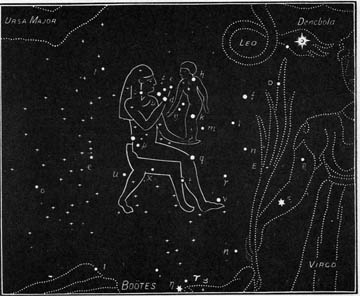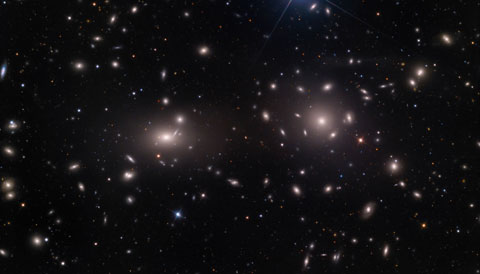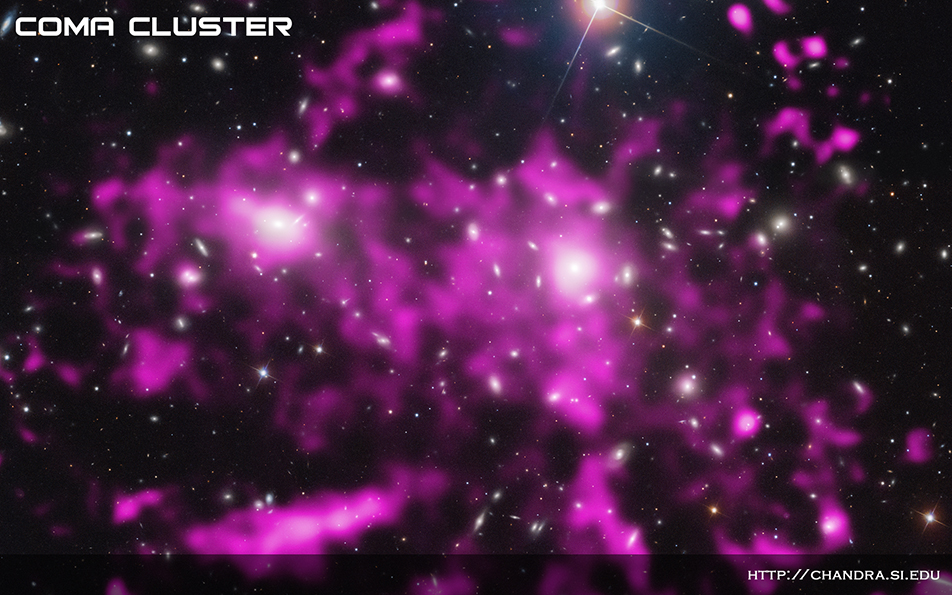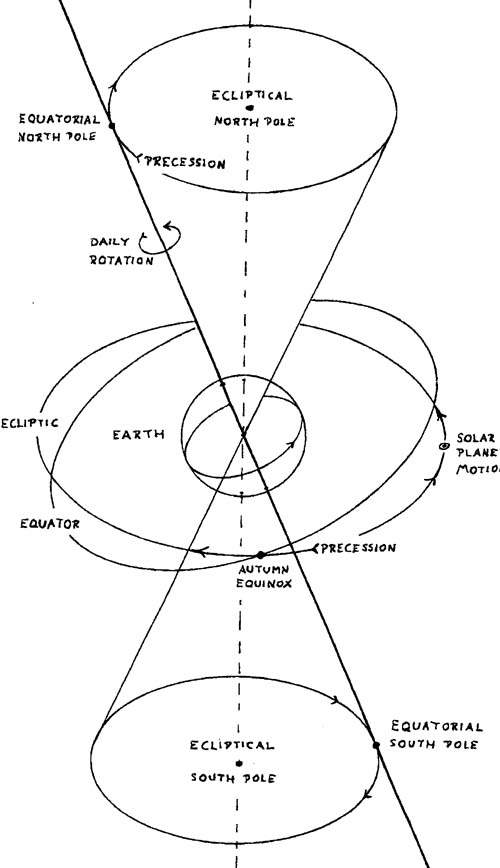
New Evidence of the Coma Supernova Framing the Birth of Christ
This blog post provides an example of Modern Astronomy and Astrophysics informing and supporting certain aspects of Ancient Astronomy, specifically surrounding the birth of Jesus Christ. With the utilization of modern analysis of images of the Coma Cluster from the Hubble Space Telescope, and the Dragonfly Telephoto Array in New Mexico, we have assembled scientific evidence in support of the 2000+ year old Coma Supernova constituting the General Sign of the Celestial Prelude historically documented by ancient luminaries like Ptolemy and Hipparchus, but unsupported beyond this until now. We will start with an excerpt from my previous articles at [try-god.com] on the Celestial Prelude, setting the context of the Coma Supernova and the Hebrew Calendar.
“The practice of Intercalation of months kept the holidays of Passover, Pentecost and Rosh Hashanah, just prior to the Feast of Tabernacles in the month of Tishri, in their proper seasons of early Spring, the beginning of Summer and at Summer’s end. This “11-day gap between the solar and lunar years expands to a period of seven months over this 19-year lunar cycle. In the Calendar of Israel a total of seven years (3rd 6th, 8th, 11th, 14th, 17th and 19th) during this 19-year lunar cycle, would normally contain an extra month of Adar Sheni.”1

With every 19 solar years plus two hours, the Sun and Moon return to meet each other at the same appointed time and place in the sky. The saros, however, consists of 19 eclipse years, which is only 18 solar years plus eleven days. An eclipse year thus consists of 346.62 solar days, which is equal to 11.738 lunations. When we divide the saros by 11.738, we get 1.618, (or phi),2 accurate to 4 digits! Since the Sun intersects a lunar Node two times every 346.62-day eclipse year, we find the cycle of the celestial rendezvous of the Sun and Moon also governed by the phi ratio. The Hebrew calendar also unifies these luni-solar cycles according to phi, in concert with Israel’s sacred fifty-year cycle of Jubilees. This is evident because there are 618 lunations in any given 50-year Jubilee cycle. Thus, as the Hebrew calendar shows the perfect correlation of the sacred and secular celestial cycles, governing the rhythms of a myriad terrestrial and cosmic cycles, we find more evidence of the signature of God the Creator and His dominion of light reflected in the heavens, the Source behind all kingdoms of earthly life. This exhibits the perfect relation between the civil [lunar], and sacred[solar] years of the Calendar of Israel, in the larger context of precession. These related sacred and secular standards are also unified in the promised seed, Jesus Christ as the Priest–King of Israel, and light of the world presiding over all circadian rhythms and other aspects of the kingdoms of terrestrial life.
As we briefly mentioned earlier, the roots of the word for saros are much older than Meton’s application of the term. In fact it goes back at least as far as ancient Sumeria, because the Sumerian name for the great lunar eclipse cycle was also called the saros. This word traces through to the basic Babylonian unit of measure, also called a “sar,” showing ancient elements of the sacred celestial rule of measure. This period of lunation consisting of 18 years & 11, (10.96) days, was utilized by the Chaldean priests to predict eclipses. Wallis Budge supported this notion when he stated; “the Babylonians were a nation of stargazers observing the appearances of the moon, eclipses, & planets etc.” This was the culture that produced the Magi, and speaks volumes on not only their astronomical expertise, but also their focus while watching the heavens for the celestial signs revealing the birth of Jesus Christ the promised seed. The Babylonians also had a period of 3600 (60 x 60) years that they called a saros. Here again we see the Sexegesimal pattern behind the organization of the heavens, including the cycle of the Moon joining Saturn and Jupiter every 60 years in their celestial dance. Jupiter-Saturn Conjunctions exhibit the essence of this “base 60” numerical system as part of its function as a cornerstone of Biblical cosmology, providing the context of the Celestial Prelude marking the birth of Christ. Additionally, it gives us a window on the “celestial mechanism” that frames all Creation, the precession of the equinoxes. This will be fully explained in the Specific signs of the Celestial Prelude. Both of these planets frame the ancient solar system as its two outer-most naked-eye planets, while opening a window on precession. It also shows a unity of Saturn’s 29.5-year orbit with the 29.5-day lunar cycle on a year-day basis. This is half the Sexegesimal order of the solar system, formatted in the orbits of these two gas giants, the other half being Jupiter’s near 12-year cycle spending a year in each zodiacal sign, even as the Sun spends a month in each of the 12 signs. The solar half of the order is based on a division of 60, by twelve: (12 x 5), and the lunar half by 30 [30 x 2], both multiples of sixty. This is part of the numerical order of the solar system as it was patterned by the Creator according to the phi ratio.
Figure 1. Precession of the Equinoxes
The Babylonian “Sar” is doubtlessly related to the Hebrew word [*H8269] of the same spelling, meaning; “prince, captain, chief, ruler, leader, head.” The word has retained this meaning even in modern usage, as in the Tsar of all the Russias. As a testimony to what may have been based on the first human language, “Aesar” is a word for “God” in both, Icelandic and Irish, “Osar” in Egypt like “Osiris” was the prince. The English word “sir” and the Roman “Ceasars” are also traceable to this root. It is used in Daniel 10:13 & 20, referring the archangel Michael who dispatched the fallen angel (Daimon) who opposed the messenger angel that God sent to answer Daniel’s prayer. In Isa. 9:6, one of the great prophecies of the birth of Jesus Christ promised seed, used of the Messiah as Sar-Shalom; the Prince of Peace, the one who brings peace to all Creation [Eph. 2:11-18]. It is additionally used of Prince Moses in Exodus 2:16.
According to Hislop, The Chaldean version of this word; “Zer,” meaning “to encompass” gives us not only the English basis for: “Zero signified by a circle among the Chaldeans,” but also Zero; “the seed.” Thus, it relates to the Hebrew word zera [*H2233] used in reference to Jesus Christ’s birth- promised seed in Genesis 3:15. To this end the Chaldean word for the “woman’s promised seed” was “Zero-ashta,” that also formed the basis of the name Zoroaster. We should note that in the writings of Zoroastrianism in the Zend-Avesta, the predicted return of Zoroaster as a savior who would renew all existence in preparation for the Last Judgment, was prophesied. These references to the woman’s promised seed point directly to the general sign of the Celestial Prelude. Hislop also notes:
“In almost all nations, not only was a great god known under the name of Zero or Zer; the seed, and a great goddess under the name of Ashta or Ishta; the woman, but the great god Zero is frequently characterized by some epithet which implies that he is The only One.” 3
This evidence provides a strong basis for a direct correlation to the decan Coma, the seed who was the desired of the nations, especially in view of the Supernova in this child’s [Christos] head [pictured below on the Dendera Zodiac] marked as the promised seed, during the general sign of the Celestial Prelude. The implication that the promised seed of the woman would be the only one, speaks to the truth that Christ is the Alpha and Omega, or the first and last way God made available for the redemption of Mankind. Hislop goes on to say: “As he who by the Chaldeans was regarded as the great Seed was looked upon as the Sun incarnate, and as the emblem of the Sun was a circle, the hieroglyphic relation between zero; “the circle,” and zero; “the seed” was easily established.”4
Figure 2. Coma Decan in the Dendera Zodiac

The Biblical references to Christ associated with the Sun as the “light of the world,” the “Sun of Righteousness” [Mal. 4:2] and in Psalm 19:4-6, are only a few of many such references. Thus, in the case of the promised seed, Zero-ashta, the religion of the Magi served as a vessel for many principles and astronomical precepts, that led Mankind to the birth of Jesus Christ as the Promised Seed of the Woman, [Gen. 3:15-16].
Ignatius, one of the Church Fathers and the Bishop of Antioch, in about 69 AD, records that, “At the appearance of the Lord a star shone forth brighter than all other stars.” If we are careful not to confuse this reference with the planet Jupiter, we can deduce that this supernova was still visible almost 200 years after it was first seen as the celestial marker of the general time frame of Jesus’ birth. Thus, the Celestial Prelude proposes that this Coma Supernova that took place in the head of the infant “Christos,” nursed by his mother was the General Sign marking the time of the Messiah’s birth. Seiss has some viable historical references on this point:
“Hipparchus about one hundred twenty-five years before Christ, observed it [Coma supernova] as a new star, and was led by it to draw up his record of stars. Ptolemy, about one hundred and fifty years after Christ, refers to it as having been observed by Hipparchus, but as having become so faint as hardly to be any longer discernible.”5 (parenthesis and emphasis mine)
Also during this same period referred to by Ptolemy above, shekels from Judea struck during the period of the second revolt, [132 AD.] bear the design of a bright star over the Jerusalem Temple, called Bar Kaukab, or Son of the Star. This would have also been a logical reference to the supernova that appeared in the head of the woman’s son in Coma‘s lap, the desired of the nations, perhaps even a providential reference to Jesus as the true temple. The decan of Coma is pictured below as the three bright stars forming the inverted “L” shape, that significantly contains the North Galactic Pole, located 5 degrees west of Beta Coma. This is interesting in light of the original star picture associated with this decan, as seen in the Dendera Zodiac, of a mother holding her Son in her lap, known as “the Desired of the Nations,” [Figure 1, above]. The close proximity of the Northern Galatic Pole, recalls the imagery of Cepheus “the crowned king” who regally sits astride the Celestial Pole star polaris, picturing Christ seated in heaven at the right hand of the Heavenly Father [Eph. 1:20-23].
Figure 3 The Decan Coma

The Magi would have witnessed both this new star shining brightly in Coma, a decan of Virgo, while Jupiter was in retrograde, standing still on the Meridian in Virgo, in December of 2 BC. The general sign of our Celestial Prelude thus harmonizes with the specific signs, as the Magi headed south from Jerusalem, their visit with Herod just concluded, towards Bethlehem in search of the promised seed. This also explains why the Magi were the only group to recognize these specific celestial signs of the Messiah’s birth, because the general sign was a fixture in Coma for about 200 years prior to this period. The typical person wouldn’t have noticed anything out of the ordinary in the heavens, because it would not stand out unless coupled with the knowledge of the specific signs, bringing the Magi to Israel in the first place. This is another reason why the Magi were so joyful when they saw “his star,” Jupiter over Bethlehem. This scenario of what the Magi beheld in the skies over Bethlehem in December of 2 BC, is depicted in the banner of this article above, and covered in detail in our website article on the Skies over Bethlehem. In Numbers 24:17, when Jacob is referred to in Balaam’s prophecy, it refers not only to the seed of Jacob, but also to the land promised to him as an inheritance, in his Covenant with God [Gen. 15:18]. Rolleston has interesting remarks regarding this:
“The Magi forewarned that the star must appear over Jacob, over his inheritance, would see that star in Coma passed over the center of that inheritance: but as it would also appear to pass vertically over every part of it that was nearly in the Latitude of Jerusalem, they could not at once fix on the spot of the Messiah’s birth, therefore they went to inquire; the Latitude, as it were, being given by the star, the longitude by the prophecy.“6
Here we see the witness of the stars, and the Scriptures, working together to bring the Magi to the toddler Jesus, because their alert observation of “his star” brought them to Jerusalem and the scribes declaration from Micah 5:2, when Herod questioned them, sent the Magi to Bethlehem. While en route they witnessed the heavens come alive with the proof that their historic journey was not in vain, because they saw both the Coma Supernova, and Jupiter in Virgo in the same skies over Bethlehem. This puts both elements of the General and Specific Signs of the Celestial Prelude in the same skies observed by the Magi leading them to the birth place of Jesus Christ.
Some Professional Astronomers following my Try-God Blog and website have doubted the veracity of the historical evidence of the ancient Coma Supernova framing the birth of Christ, and have challenged this point, citing the lack of physical and scientific proof of this event. With this in mind, we present the following research that has come out in the last year or so, providing key astronomical research supporting the thesis of this ancient Coma Supernova. The following are excerpts from a Sky & Telescope article from November 2014 by Monica Young, a professional astronomer by training, and web editor/contributor for Sky & Telescope Magazine.
Figure 4. Some of the 800+ Dark Galaxies Pictured in the Coma Cluster.

“Pieter van Dokkum (Yale University) and colleagues took a unique look at Coma through the Dragonfly Telephoto Array, eight Canon cameras armed with telephoto lenses. The Dragonfly is designed to find faint, fuzzy blobs, but what its images revealed surprised the team. The research team included astronomers from San Jose State University, the University of Toronto, and the University of California-Santa Cruz. The team made its discovery by combining results from the Dragonfly Telephoto Array — which van Dokkum helped to invent — and the W.M. Keck Observatory’s 10-meter Keck I telescope. The team’s observations wrapped up in May, but it wasn’t until later in the summer that van Dokkum finally got around to looking at the images he’d gathered. In them, he noticed some faint, fuzzy blobs. Forty-seven blobs, to be precise. They looked rather large, and they really weren’t supposed to be there – at least, not according to the records keeping track of galaxies in the cluster.
Once these blobs were inspected they found them to be “dark Galaxies.” On Coma’s outskirts lurk 47 galaxies similar in size to the Milky Way — but with 1,000 times fewer stars. To survive in crowded Coma, these dark galaxies must contain 98%+ dark matter to hold themselves together, much higher than the fraction in the universe at large (73%).”
The galaxies’ size depends on their distance, so to make sure this result wasn’t just a trick of perspective, the team had to make sure these galaxies really belonged to the Coma cluster, more than 320 million light-years away. Determining cluster membership was a challenge because the objects are far too faint to study in the usual ways, such as taking a spectrum to determine their distance. Nonetheless, “van Dokkum and his co-authors make quite a convincing case,” says Mark den Brok (University of Utah).
To estimate the galaxies’ distance, the team traced the blobs’ distribution on the sky. It matched that of the Coma Cluster’s galaxies, suggesting the 47 objects were indeed a part of the cluster. Then, the team again turned to archival images — this time, those shot by Earth’s sharpest eye in the sky, the Hubble Space Telescope, which had observed the Coma Cluster many times before. Completely by chance, Hubble had captured three of the faint galaxies. One of the images was good enough to work with. In that image, there’s a faint, blurry galaxy hanging out with Coma’s classic inhabitants. But the galaxy’s individual stars aren’t resolved by Hubble, which suggests the blob is very far away indeed. The team simulated Hubble images taken at varying distances, and calculated that in order for the individual stars to be invisible, the galaxy needed to be at least 160 million light-years away.
Which means, the blob – and most of its friends – are probably in the Coma Cluster. “We conclude that most or all of the low surface brightness galaxies are, in fact, at the distance of the Coma cluster and are resolved in the Dragonfly data because they are intrinsically very large,” the authors write.
Figure 5. Coma Cluster From Chandra X-Ray Observatory

The authors initially expected the galaxies to be distributed randomly, as they would be if they lay in the foreground near the Milky Way. Instead, the galaxies cluster around the center of the image in the cluster’s periphery. Suspecting the objects might be clumps of galaxies too small for Dragonfly to resolve, in the team’s search through archival images of the region shot by a telescope that should be able to parse giant blobs into smaller, constituent objects. The discovery of a serendipitous Hubble image of one of the galaxies supported the team’s case, den Brok says, definitively showing that it doesn’t have the traits of a nearby dwarf galaxy. [Reference: Pieter van Dokkum et al. “Forty-Seven Milky Way-Sized, Extremely Diffuse Galaxies in the Coma Cluster.” Astrophysical Journal Letters, submitted.]
Starless Galaxies
Simulations that track the evolution of large-scale cosmic structure suggest that even normal galaxies start out with three times more star-building material than they develop into stars. So whatever process works to limit star formation in normal galaxies is working particularly well in these dark matter-rich galaxies.
“Our simulations have shown that one way to limit star formation so drastically is to use the energy stars produce when they blow up as supernovae,” says Greg Stinson (Max Planck Institute for Astronomy, Germany). “It turns out that this disruption leads directly to galaxies that look like the ones van Dokkum is seeing.”

“How did such bizarre and difficult-to-detect galaxies arise? Team member Pieter van Dokkum, astronomer at Yale University, suspects the galaxies may be failed Milky Ways—big galaxies that were headed for brilliance but lost their gas before forming many stars, perhaps because supernova explosions catapulted gas out of the galaxies and into the parent Coma cluster. They also must harbor lots of dark matter to hold together; otherwise the gravitational pull of other galaxies in the cluster would rip them apart.”
“I was actually very much relieved to see Prof. van Dokkum’s paper,” Stinson adds. Dark matter simulations have been producing galaxies with exactly the size and matter distribution that van Dokkum’s team observed, but such galaxies are naturally difficult to observe.”
It’s ironic that dark matter-rich galaxies were discovered in Coma, the birthplace of dark matter theory. Observations of the same cluster in 1933 helped Fritz Zwicky (Caltech) first conceive of the invisible matter that shapes the large-scale structure of the universe. Zwicky was also involved in Supernova discoveries in Coma during the 50’s and early 60’s. Now ever-deeper observations continue to help astronomers understand dark matter’s role in the galaxy.
Seeing this research on the Coma Cluster was intriguing to me. What if these diffuse galaxies could somehow support the history we had already seen on the Coma Supernova? Since these diffuse starless galaxies in the Coma Cluster were so limited in their star-making material, and a known cause of this is an exploding supernova in the region, would have depleted the energy galaxies used to form these stars, then we might be on to an explanation, not only of these diffuse galaxies in the Coma Cluster, but also provide modern scientific evidence of this ancient Coma Supernova. But, to more conclusively link a Nova/Supernova to these diffuse galaxies, we need to know more about how Nova explosions occur in general. Since this initial discovery of 47 Ultra Diffuse Galaxies [UDG’s] in the Coma Cluster, by this team, additional research has revealed over 800 added UDG’s in the same Coma Cluster. The following reference documents this.
STONY BROOK, NY, June 22, 2015 – A team of researchers from Stony Brook University and the National Astronomical Observatory of Japan (NAOJ) have discovered 854 “ultra-dark galaxies” in the Coma Cluster by analyzing data from the 8.2-meter SubaruTelescope. The new discovery, published in the June 2015 editionof the Astrophysical Journal Letters, surpasses the 2014 discovery of 47 dark galaxies by more than 800 and suggests that galaxy clusters are the key environment for the evolution of these mysterious dark galaxies.
“The findings suggests that these galaxies appear very diffuse and are very likely enveloped by something very massive, “said Jin Koda, PhD, principal investigator of the study and Associate Professor in the Department of Physics and Astronomy at Stony Brook University.
[See more at: http://sb.cc.stonybrook.edu/news/general/150622854ultradarkgalaxies.php#sthash.GE37hY7t.dpuf]
“We are beginning to form some ideas about how they [Dark galaxies] were born and it’s remarkable they have survived at all,” van Dokkum said. “They are found in a dense, violent region of space filled with dark matter and galaxies whizzing around, so we think they must be cloaked in their own invisible dark matter ‘shields’ that are protecting them from this intergalactic assault.”
This discovery can become very important for modern astronomy because it may lead to revision of fundamental theories.
“A central tenet of galaxy formation is that “as we count the number of stars, we can predict the amount of dark matter” holding the galaxy together,” said van Dokkum, as quoted by the Christian Science Monitor.
“If you have two galaxies, the Milky Way and one of these things, which have a very different number of stars but the same amount of dark matter, that simple idea doesn’t hold,” he added. “They [UDGs] prove to be “a Rosetta Stone for galaxy formation,” concluded Jin Koda.
Publication: Pieter G. van Dokkum, et al., “Spectroscopic Confirmation of the Existence of Large, Diffuse Galaxies in the Coma Cluster,” 2015, ApJ, 804, L26; doi:10.1088/2041-8205/804/1/L26
Figure 6. Virgo and Coma from Stellarium Astronomy Software
![]()
This new research provides added probable evidence for the Coma Supernova documented by the ancients Hipparchus and Ptolemy, which from their historical records states that the Coma Supernova was visible to the naked eye for at least a period of about 275 years.
In summary then, the key points regarding the general sign of the Celestial Prelude are first, this Supernova in Coma, set the general time frame in which the Magi were to expect the specific signs surrounding the birth of Christ. Secondly, when this general sign is separated from the set of specific signs of Jupiter-Saturn triple conjunctions, the confusion clouding the “Star of Bethlehem,” for the most part dissolves. Thirdly, When the Magi beheld the heavens above Bethlehem they witnessed both the bright Coma Supernova in the child’s head, while Jupiter shone down standing still in the heavens in retrograde motion in Virgo, during the Winter Solstice, when the Sun was standing still also, clearly marking the birth-place of Jesus Christ.
FOOTNOTES:
1 Symbols of Judaism M.A. Ouaknin p.12.
2 Sun, Moon and Earth. Robin Heath, p.28
3 The Two Babylons Hislop, p. 59
4 The Two Babylons Hislop, p. 18
5 Gospel in the Stars, Joseph Seiss. P.161.
6 Mazzaroth; The Star of Bethlehem, Rolleston,
*Strong’s Concordance word definition for H8269, H2233, etc.
CATEGORIES
Cosmology, Galaxies, News
Monica Young, a professional astronomer by training, is web editor and contributor for Sky & Telescope, where she creates, manages, and maintains website content, and contributes to the magazine.
View all posts by Monica Young – See more at: http://www.skyandtelescope.com/astronomy-news/dark-matter-rich-galaxies-discovered-111820141/?et_mid=705239&rid=246729655#sthash.ocjmowt5.dpuf
Reference: Pieter van Dokkum et al. “Forty-Seven Milky Way-Sized, Extremely Diffuse Galaxies in the Coma Cluster.” Astrophysical Journal Letters, submitted
Wide-field image of the Coma Cluster of galaxies. (Adam Block/Mount Lemmon SkyCenter/University of Arizona)
Hubble Space Telescope close-up of one of the Coma Cluster’s beautiful spiral galaxies, NGC 4911. (NASA/ESA/Hubble Heritage Team)
The Dragonfly Telephoto Array is designed to image low surface brightness objects. Dunlap Institute for Astronomy & Astrophysics / University of Toronto.
See more at: http://sb.cc.stonybrook.edu/news/general/150622854ultradarkgalaxies.php#sthash.GE37hY7t.dpuf
Publication: Pieter G. van Dokkum, et al., “Spectroscopic Confirmation of the Existence of Large, Diffuse Galaxies in the Coma Cluster,” 2015, ApJ, 804, L26; doi:10.1088/2041-8205/804/1/L26
